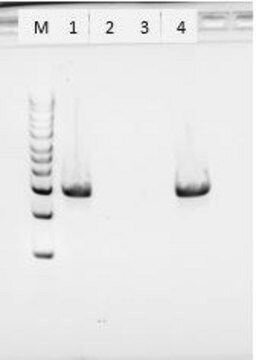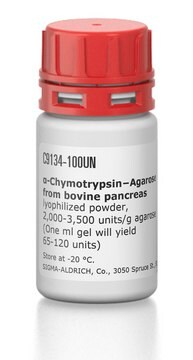P9290
Proteinase K–Agarose from Tritirachium album
lyophilized powder
Synonym(s):
Proteinase K-Agarose
Sign Into View Organizational & Contract Pricing
All Photos(2)
About This Item
Recommended Products
biological source
microbial (T.album
T. ALBUM)
Quality Level
form
lyophilized powder
extent of labeling
30-140 units per g solid
technique(s)
DNA extraction: suitable
RNA extraction: suitable
protein extraction: suitable
swelling
1 g swells to ~5 mL
storage temp.
−20°C
Application
Proteinase K-agarose is used in protein and nucleic acid isolation, modifying enzymes and immobilized enzymes. Proteinase K-agarose has been used to study Klebsiella pneumonia as well as Echinococcus multilocularis infection in domesticated dogs.
Biochem/physiol Actions
The application of proteinase K has been extended by immobilizing it on an insoluble matrix such as agarose. The agarose is quite inert in most systems and allows high activities per unit weight. This reactive resin allows the enzyme reaction to be quickly catalyzed by momentary contact with the substrate in a suitable medium. Reactions can be carried out in a batch slurry or even through a small column. In either case, the insoluble enzyme does not contaminate the reaction mix, which can be readily filtered out of the batch slurry or remain behind in the column.
Features and Benefits
• Recylable Proteinase K on matrix support.
• Spin column or batch processing possible.
• Spin column or batch processing possible.
Unit Definition
One unit will hydrolyze urea-denatured hemoglobin to produce color equivalent to 1.0 μmole (181 μg) of tyrosine per min at pH 7.5 at 37 °C (color by Folin-Ciocalteu reagent).
Physical form
Lyophilized powder stabilized with lactose
Storage Class Code
11 - Combustible Solids
WGK
WGK 3
Flash Point(F)
Not applicable
Flash Point(C)
Not applicable
Choose from one of the most recent versions:
Already Own This Product?
Find documentation for the products that you have recently purchased in the Document Library.
Customers Also Viewed
Hirokazu Kouguchi et al.
Experimental parasitology, 128(1), 50-56 (2011-02-09)
We show that a conventionally purified glycoprotein component of Echinococcus multilocularis protoscolex, designated as Emgp-89, may be useful as a serodiagnostic antigen for detecting E. multilocularis infection in dogs domesticated in endemic areas. Emgp-89 was obtained from the parasite material
Zohar Erez et al.
Nature, 541(7638), 488-493 (2017-01-19)
Temperate viruses can become dormant in their host cells, a process called lysogeny. In every infection, such viruses decide between the lytic and the lysogenic cycles, that is, whether to replicate and lyse their host or to lysogenize and keep
Comparison of three methods of DNA extraction in endocervical specimens for Chlamydia trachomatis infection by spectrophotometry, agarose gel, and PCR
Jenab, A., et al.
Arch. Immunol. Ther. Exp., 58, 227-234 (2010)
M J Pearse et al.
Immunology letters, 18(3), 219-223 (1988-07-01)
This report describes a method for preparing both DNA and RNA simultaneously from as few as 5 X 10(5) lymphoid cells. The method is suitable for cultured cells or any tissue from which a cell suspension can be prepared and
Shai Eyal et al.
Development (Cambridge, England), 146(4) (2019-02-13)
Sesamoid bones are small auxiliary bones that form near joints and contribute to their stability and function. Thus far, providing a comprehensive developmental model or classification system for this highly diverse group of bones has been challenging. Here, we compare
Our team of scientists has experience in all areas of research including Life Science, Material Science, Chemical Synthesis, Chromatography, Analytical and many others.
Contact Technical Service





